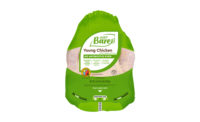Ham sector activity is accelerating.
With processors responding to greater shopper interest in smaller and increasingly flavorful selections, ham is becoming a more popular everyday meal alternative, analysts say.
Smoked ham dollar and unit sales in 2020 were up 16.3 percent and 12 percent, respectively, versus the year-earlier period, according to Information Resources Inc. (IRI), a Chicago-based market research firm. While the large base of consumers eating more meals at home because of the COVID-19 pandemic contributed to the gains, smoked ham activity was already steadying with dollar and unit sales decreasing 0.9 percent and 2.9 percent, respectively, in 2019, after falling 3.8 percent and 3.2 percent in 2018.
“It is important for retailers to support the category, which fits the bill of an easy, versatile, kid-friendly and tasty cut that has done well in the past 18 months,” says Anne-Marie Roerink, principal of 210 Analytics LLC, a San Antonio-based market research and marketing strategies firm.
The growing number of smaller empty-nest families and younger consumers seeking smaller portions, along with a decline in family get-togethers during the pandemic, are fueling the popularity of smaller hams, including quarter pre-sliced, half spirals and ham steaks, says Kiersten Hafer, strategy and insights consultant with the Des Moines-based National Pork Board (NPB).
More merchandisers, meanwhile, are offering wider varieties of ham as they try to make it a more attractive alternative for breakfast, lunch or dinner throughout the year, rather than just an Easter, Thanksgiving and Christmas meal, she says.
Retailers also are increasingly positioning ham as a convenience selection by offering such options as pre-sliced, cubed and ham in julienne strips for use as an ingredient in salads, casseroles and other recipes, Hafer says. She notes that packers and processors are further adding to the allure by creating products with cleaner labels, such as uncured hams that are free of sodium nitrates or nitrites and other chemicals and additives.
Operators also are developing more flavor profiles by using different scents during the smoking and curing process, Hafer says.
It is important for merchandisers to aggressively market the selections, which can include spotlighting product benefits, in order to sustain and enhance activity, analysts say. That can include highlighting that there is less potential waste from serving smaller hams and the subsequent guilt from needing to discard food, Hafer says, adding that many consumers are “more engaged and happier with the smaller products.”
Production can be a problem
The attractiveness of developing smaller ham options is offset in part by operational challenges some processors may face, says Kevin Sheehan, NPB director of processor engagement. That includes having the necessary personnel to support a more labor-intensive production process, which includes deboning, he says.
“A traditional bone-in or spiral-cut ham that is the back half of the pig is a big piece of meat, and there is little the processor needs to do other than to make sure that it is good, clean, and wholesome,” Sheehan says. “Smaller hams require pulling the muscle apart, and there is no automated equipment that can do it efficiently. It is a very hands-on process.”
It also is typically more costly for processors to develop uncured hams with clean labels, Hafer says, which is leading merchandisers to add further value to the products, such as by offering pre-sliced selections, to compensate for the higher retail price tag.
Retailers can further make their ham options more appealing by leveraging attractive labels, offering recipe suggestions, providing a wide array of package sizes and brands, and cross-merchandising the products with other meal components, Roerink says.
“Having a variety of portion sizes is important in order to support gatherings of all sizes,” she says, “otherwise, ham runs the risk of being replaced by something that is more easily adapted to a smaller size, like a ribeye.”
Roerink adds that the use of ham in protein kits and merchandising higher-quality selections also create attractive sales opportunities. “There is tremendous growth in premiumization that is driven by people wanting to do something nice and special for themselves and their families,” she says. “The challenge is to give people a reason to splurge.”
For more information about ham processing, please visit the following suppliers:
AmTrade Systems Inc.Fristam Pumps USA
Handtmann Inc.
M&M Equipment Corp.
Marel
Middleby Food Processing
Poly-Clip System
QMS International
Reiser
Tipper Tie/JBT FoodTech





Report Abusive Comment